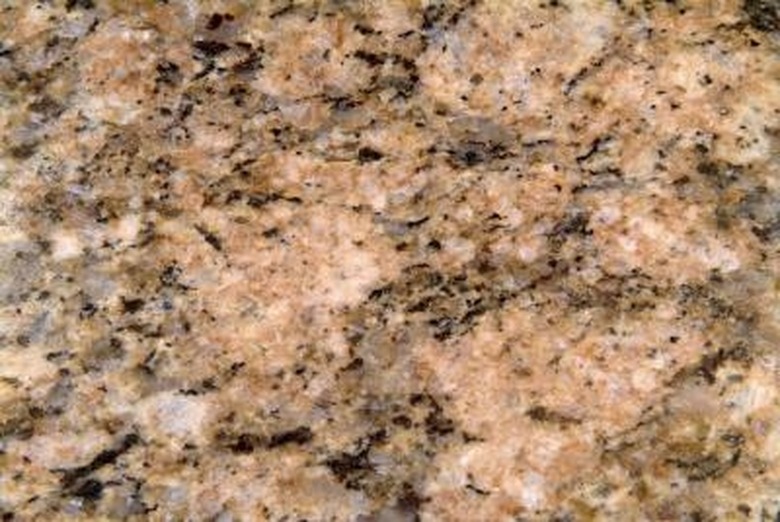Difference Between Quartzite & Granite
There are several differences between quartzite and granite. Granite gets its hardness from its quartz content, but quartzite contains more quartz per volume than granite, making it essentially a harder material. Granite is more abundant than quartzite; it is widely distributed throughout the earth's crust and forms the foundation that underlies the sedimentary rock beneath most of the continents.
Formation
Formation
Quartzite is a metamorphic rock that forms from the joining of sandstone and quartz under intense heat and pressure. This material is often found where regional or contact metamorphism took place. Regional metamorphism is the process in which quartzite is formed under more pressure than heat, while contact metamorphism involves more heat than pressure. Sandstone is often compacted into quartzite when continents collide, filling in empty grains of sandstone with quartz. Granite forms at greater depths than quartzite, but similar to quartzite, granite requires some levels of pressure and heat to form. Granite is a type of igneous rock that typically forms underneath continents. It forms when liquid magma cools into existing rock formations.
Hardness
Hardness
Quartzite and granite are both very hard materials, which lends to their many practical applications. Hardness can be measured on the Mohs scale of hardness. This scale, with a range from 1 to 10, designates harder materials with higher numbers. Quartzite offers an approximate value of 7 on the Mohs scale while granite offers a hardness value of between 6 and 6.5 on the Mohs scale. Quartzite is often employed in the creation of railway ballasts and borders for flowerbeds. Granite is often mined in slabs for the fabrication of tiles, gravestones and countertops. The quartz contained within these materials contributes to their hardness. Quartz offers a 7 on the Mohs hardness scale.
Components
Components
Any rock that contains 10 to 50 percent quartz and offers an alkali-to-feldspar ratio between 65 and 95 percent is defined as granite. Granite typically contains a combination of quartz, mica, feldspar and hornblende. Biotite, magnetite, garnet, zircon and apatite may also be involved in the formation of granite if the materials are present. Quartzite is made out of sandstone, silica, iron oxide, carbonate, clay and a very large percentage of quartz.
Color
Color
Granite can contain many different materials in its composition. Each component in granite can affect the overall appearance of the granite in terms of color. The color of granite can vary dramatically based on location. For example, granite mined in the eastern United States may offer similar properties to granite mined on the opposite side of the country but appear quite different. Feldspar, which can appear many colors — from green to pink — can greatly affect the color of granite. Quartzite in general appears white to gray. However, certain components, such as iron oxide, can vary the color of quartzite. Quartzite that is heavy in iron oxide may appear pink to red in color. Quartz can form in colors such as yellow, rose or brown, thus affecting the overall color of both quartzite and granite.
References
Cite This Article
MLA
Leone, Jay. "Difference Between Quartzite & Granite" sciencing.com, https://www.sciencing.com/difference-between-quartzite-granite-8594861/. 24 April 2017.
APA
Leone, Jay. (2017, April 24). Difference Between Quartzite & Granite. sciencing.com. Retrieved from https://www.sciencing.com/difference-between-quartzite-granite-8594861/
Chicago
Leone, Jay. Difference Between Quartzite & Granite last modified March 24, 2022. https://www.sciencing.com/difference-between-quartzite-granite-8594861/
